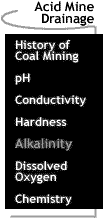

 |
Acid Mine Drainage: Alkalinity Alkalinity is a measure of the buffering capacity of a solution. Chemical buffering is the resistance of a solution to changes in pH. Because pH is a measure of the number of hydrogen ions in a solution, alkalinity represents the ability of a solution to absorb or take up hydrogen ions. Hydrogen ions are taken up by molecules, such as carbonates and bicarbonates, because the negatively charged ions bond with the positively charged hydrogen ions thereby removing the hydrogen from the solution. The bicarbonate buffering system works in stream ecosystems much in the same way as it does in your blood stream. As shown in the diagram below, bicarbonate, and sometimes carbonate, molecules act as hydrogen ion absorbers. This causes the reactions of the bicarbonate buffering system to shift left or right, but allows the pH of the solution to remain relatively unchanged. If hydrogen ions are added to the solution, they combine with available bicarbonate or carbonate ions causing the reactions to shift to the left and eventually liberate carbon dioxide and water molecules. Addition of carbonate to the solution causes the hydrogen ions to be occupied and shifts the reaction to the left if hydrogen ions are available. The addition of rainwater, on the other hand, may shift the reactions to the right. The normal pH of rainwater is about 5.6, a weak carbonic acid solution resulting from the mixing of water molecules with carbon dioxide molecules in the atmosphere. Carbonic acid is weak, because some of the carbonic acid molecules dissociate into hydrogen ions and bicarbonate ions. Chemical reactions of the
Streams with a pH of 6 or lower have very little buffering capacity. The dominant form of inorganic carbon in the bicarbonate buffering system is free carbon dioxide, as shown in the diagram above. Streams, such as Wheeling Creek, which have pH readings typically in the 8-8.5 range, are very resistant to changes in pH. Most of the inorganic carbon in Wheeling Creek is bicarbonate. Streams with pH readings above 11 are very rare, but should they occur, carbonate would be the dominant inorganic carbon in the bicarbonate buffering system. [ Acid
Mine Drainage: History of Coal Mining /
pH / Conductivity / [ Sewage ] [ Agriculture ] [ Dredging ] [ Home ] [ Teacher Pages ] [ Modules & Activities ] |
HTML code by Chris Kreger
Maintained by ETE Team
Last updated November 10, 2004
Some images © 2004 www.clipart.com
Privacy Statement and Copyright © 1997-2004 by Wheeling Jesuit University/NASA-supported Classroom of the Future. All rights reserved.
Center for Educational Technologies, Circuit Board/Apple graphic logo, and COTF Classroom of the Future logo are registered trademarks of Wheeling Jesuit University.